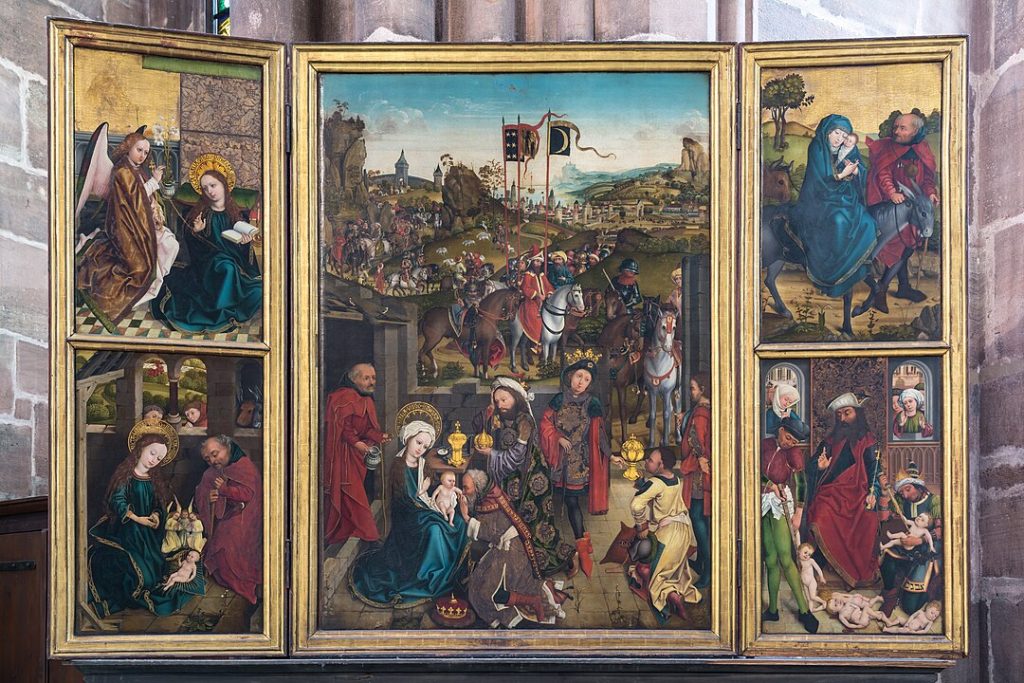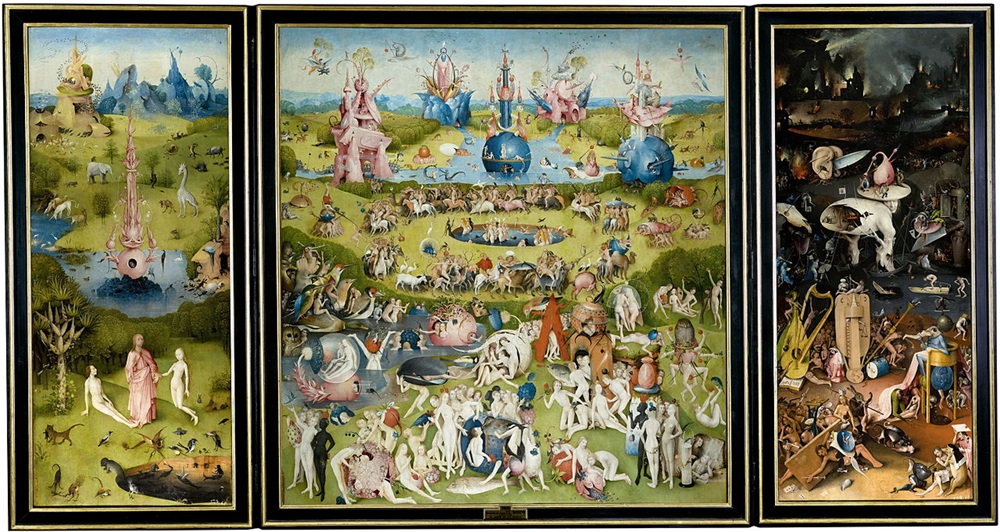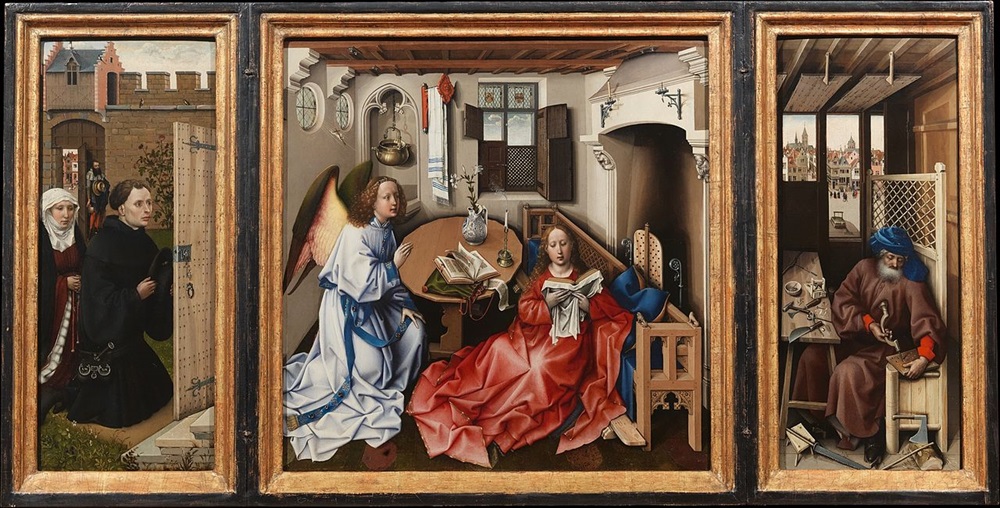History of Triptych Art
A triptych is a visually striking piece of art comprising three panels linked and exhibited together. Triptychs, which have their roots in early Christian traditions, have developed over centuries into a vital art form that explores a wide range of issues in contemporary forms, transcending their religious origins. The Greek word “triptychs,” which means “three-layered” or “three folds,” is the source of the word “triptych,” which accurately characterises its form and structure. The art of triptychs dates back to the Middle Ages when they were a crucial part of Christian altarpieces. These ancient triptychs were designed to encourage worshippers’ devotion and prayer and were mainly utilised in churches and other places of worship. Biblical stories would usually be portrayed in the middle panel, with supporting scenes or details that complemented the main story presented in the side panels. Triptychs were helpful for religious purposes since their compact size made them easy to transport and keep.
Many artists and cultures modified the triptych format as the art form developed. Triptychs were a typical tool employed by Renaissance artists, such as Hans Memling and Hieronymus Bosch, to communicate intricate stories and explore morality, humanity, and divine themes. Bosch is credited with pushing the limits of conventional triptych storylines with his painting “The Garden of Earthly Delights,” which he created between 1490 and 1510. It features fantastical themes of paradise, temptation, and hell. This shift in the subject matter of triptychs indicates the time’s shifting intellectual and cultural circumstances.
Throughout history, triptychs have been essential in both religious and secular contexts. Used initially as altarpieces, they promoted worship and communicated important Christian principles. The three-panel pattern represents Several essential Christian ideas, one of which is the Holy Trinity, which has special significance in Catholic doctrine. Furthermore, triptychs were frequently painted in great detail, demonstrating the artist’s skill and dedication. Triptychs represent the historical value of narrative in art in a larger cultural context. Artists can portray stories that progress from left to right, leading viewers through various events or emotions, thanks to the three-panel composition. Thanks to their narrative possibilities, triptychs are a standard format in many artistic traditions, from modern installations to mediaeval altarpieces.

Triptychs have been revived and reinterpreted by a variety of artists in the modern era to explore new subjects and concepts. Francis Bacon, for example, used the triptych format in “Three Studies for Figures at the Base of a Crucifixion” to convey existential concerns and psychological depth. Bacon’s triptychs frequently address themes of mortality, alienation, and the human condition, demonstrating the format’s adaptability to subjects other than religion. Triptychs are aesthetically pleasing mainly because of their compositional and structural elements. Artists can weave a unified visual story that captivates viewers with a three-part framework. The arrangement of the three panels enhances the piece’s focal point while preserving overall presentation balance. The central panel is often more extensive than the side panels. The three panels might vary in size.
Contemporary Relevance and Adaptation
Creating triptych art involves various techniques, including carefully selecting colour palettes, materials, and themes. Artists may employ traditional mediums such as oil on wood or canvas and mixed media to produce diverse interpretations of the triptych format. The choice of materials significantly influences the artwork’s visual texture and emotional resonance. Artists frequently play around with the relationships between the three panels in composition. This could be in the form of opposing imagery, overlapping pieces, or common motifs that encourage viewers to interact with the artwork differently. The visual links between the panels deepen the viewer’s experience and add to the intricacy of the story.
Artists of the modern triptych utilise the format’s innate ability to tell complex stories. For example, photographers might put up triptych compositions that show several angles on a single subject or event, provoking viewers to consider how disparate experiences are connected. The triptych’s development in modern art demonstrates its applicability in discussing modern human experiences.
Transformative Potential
Additionally, the triptych format has the power to revolutionise both viewer interaction and artistic practice. Artists are encouraged to push the boundaries of their creativity and try out novel perspectives and representations of subjects when they create a triptych. Deeper meanings and narratives are frequently fostered by this process, allowing for a richer study of themes and concepts. Furthermore, a viewer’s experience interacting with triptychs might be distinct based on how they interpret the connections between the three panels. Individuals may have quite different personal perceptions and emotional connections from this exploration. Viewers are encouraged to ponder the links between the panels and the overall story that they portray by looking at triptychs.
The triptych format will probably always be a vibrant and vital way for artists to express themselves as art changes. Artists will keep experimenting with it as they interact with current issues and social narratives. Tritychs’ adaptability to different media and technologies allows artists to explore new creative and innovative avenues. Triptychs can also be successfully incorporated into installations that question conventional viewing contexts, as immersive experiences are becoming increasingly common in exhibitions and installations. Artists can enhance their work’s aesthetic and sensory impact by encouraging viewers to move through and around the panels, creating a dialogue between them and the surrounding environment.
Famous triptych art

The Garden of Earthly Delights, a triptych by Hieronymus Bosch, which was produced between 1490 and 1510, is among the most famous in Western art. This captivating piece shows the world’s birth in the left panel, a sinful paradise in the centre, and the suffering of hell in the right panel. The vibrant and weird imagery in the middle panel tackles themes of morality and temptation. It presents a surreal setting full of creatures that warn of the repercussions of such excess and individuals delighting in earthly delights. In addition to showcasing his artistic style, Bosch’s triptych portrays the conflicts between sin and redemption that characterised late mediaeval society. The piece, a favourite topic of study for art historians and enthusiasts, critically portrays human behaviour.
Matthias Grünewald’s Isenheim Altarpiece, painted in the early 16th century, is another classic triptych in Western art. This triptych was made for a St. Anthony hospital in Isenheim, France, and is well known for its potent religious imagery that comforts the sick. The Crucifixion is depicted in the central panel, emphasising Christ’s suffering. On the other hand, St. Sebastian is portrayed in the left panel, and St. Anthony is portrayed in the right panel. This contrast highlights the hospital’s goal of treating patients with illnesses, including ergotism, also referred to as St. Anthony’s fire. A significant turning point in Renaissance art, Grünewald’s work emphasises the frailty of the human experience via the depth of emotion and spiritual sorrow it conveys.
Another important example of a triptych painting is the 15th-century Portinari Altarpiece by Hugo van der Goes. This piece was created on commission for the Santa Maria Nuova Hospital in Florence. It features the Nativity scene in the centre, with panels depicting the Annunciation and the Adoration of the Magi surrounding it. Van der Goes creates a moving visual depiction of devotion and piety by capturing the scene’s holiness with exquisite details and vibrant colours. The altarpiece is considered one of the most important examples of Northern Renaissance art because of its emphasis on human emotion and narrative coherence.
The Last Judgment by Hans Memling, produced in the late 15th century, is a stunning triptych representing the biblical topic of judgment and the dividing of souls between heaven and hell. The middle panel highlights Christ as the Judge, surrounded by angels and the redeemed souls on one side and the condemned on the other. Memling’s ability to depict emotion and the human condition is demonstrated in this triptych, primarily through the figures’ expressive gestures. The triptych is an essential example of early Netherlandish painting because of its vivid colours, minute details, and deep symbolism. The Last Judgment’s moral and spiritual ramifications are well conveyed to viewers by Memling, which highlights the triptych’s ongoing significance in religious art and the larger framework of Western art history.
Francis Bacon’s Three Studies for Figures at the Base of a Crucifixion, which he created in the 20th century, is a potent example of the triptych genre. Finished in 1944, this piece tackles issues of suffering, existential crises, and the human experience by featuring three deformed figures taken from the depiction of Christ’s Crucifixion. The unorthodox figure depiction and unadulterated emotional impact of Bacon’s triptych defy conventional ideas of form and beauty. The bleak, eerie imagery prompts viewers to consider pain and death, illustrating how the triptych structure has continued to develop in modern art.
The Garden of Earthly Delights, the Isenheim Altarpiece, the Portinari Altarpiece, The Last Judgement, and Three Studies for Figures at the Base of a Crucifixion—the famous triptychs under discussion—represent essential turning points in the history of Western art. Each piece demonstrates the triptych format’s adaptability as a framework for examining a variety of subjects, from morality and dedication to the human condition and existential suffering. Trilogy art has allowed artists to communicate intricate storylines and intense emotional experiences for millennia. It highlights its importance and relevance throughout Western history’s artistic trends and socioeconomic settings.





